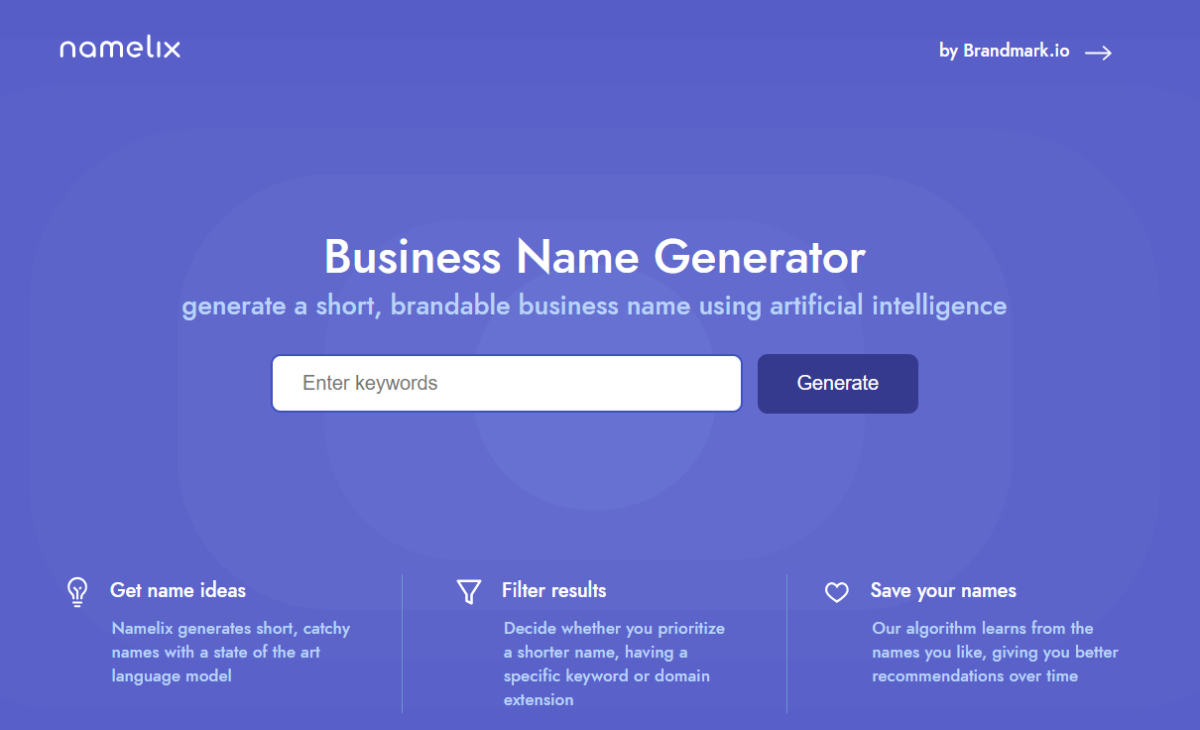In today’s expansive and fiercely competitive business landscape, the art of devising an impactful brand name holds paramount importance.
A meticulously crafted brand name possesses the remarkable ability to encapsulate the very core of your business, granting you a decisive edge in the competitive arena. In an era where every aspect of your brand is closely scrutinised, from its visual identity to its core values, the brand name guides customers to what you have to offer.
In short, the brand name is the shorthand for your entire business and its importance cannot be overemphasised.
This comprehensive article stands as your ultimate guide, leading you through the step-by-step journey of crafting an engaging brand name that deeply resonates with your target audience while laying the foundation for your success in the ever-evolving business landscape.
Importance of a Strong Brand Name
A strong brand name holds immense weight in the realm of the competitive business landscape. It goes far beyond mere wordplay; it acts as your business’s very face.
When customers encounter your brand name, it leaves a lasting impression, embedding itself in their minds long after the initial encounter.
A compelling brand name has the power to convey your company’s values, personality, and unique selling proposition to your target audience. It is a beacon of trust that draws customers towards your brand and establishes a solid brand recognition and loyalty foundation.
Well-crafted brand names are the cornerstone upon which brand recognition and loyalty are built. Some examples of brands with well-crafted names are Nike, Apple, and Google.
We’ll explore how these brands came up with the names in the coming sections.
Brand Name Creation Process
1. Understanding your target audience
To create a remarkable brand name, it’s crucial to gain a deep understanding of your target audience.
Get into their minds and desires.
Who are they? What are their interests, preferences, and values? More importantly, what are their pain points? By immersing yourself in the psyche of your target audience, you can develop a brand name that resonates with them on an emotional level.
Conduct competitor analysis and study your competitors’ brand names. Identify what works and what doesn’t in your industry to help you find a unique angle for your brand name.
Consider their language, culture, and aspirations to craft a name that speaks directly to their needs and desires. If you align your brand name with your target audience’s identity and aspirations, you create a powerful connection that resonates and builds loyalty.
Think about the long-term scalability of your brand name. Will it still make valid sense as your business diversifies its offerings? Are you still able to use the same name without limiting the brand’s future potential?
2. Brainstorming brand name ideas
Brainstorming brand name ideas can be an exciting process where you get to unleash your creativity and let your imagination run wild and wide.
After researching and gaining a deep understanding of your audience, start by compiling a list of keywords and concepts closely tied to your business and its offerings. Delve into the core values you wish to communicate and consider the range of emotions you aim to evoke.
Embrace techniques like mind mapping or engage in creative exercises that help generate a vast array of possibilities. Consider visual brainstorming tools such as XMind to organise your thoughts visually and name evaluation tools such as Namelix to evaluate the availability and potential of brand names.

Allow your imagination to run wild and explore various avenues that align with your brand’s identity and resonate with your target audience.
As you navigate the brainstorming process, encourage yourself to think beyond the conventional and challenge the boundaries of creativity. Embrace a mindset that embraces innovation and uniqueness. Consider wordplay, alliteration, or even combining unexpected elements to create a distinctive and memorable brand name. The goal is to capture the essence of your business and leave a lasting impression on your audience.
Remember, brainstorming is an iterative process. Keep refining and iterating on your ideas as you progress. Seek feedback from colleagues or conduct focus groups to gauge their reactions and perceptions.
Their invaluable input will guide you in narrowing down the options and ultimately selecting the most compelling brand name that perfectly encapsulates your business and resonates deeply with your target audience.
Investing time and effort into this crucial stage lays a strong foundation for a brand name that sets you apart, captivates your audience, and paves the way for your business’s success.
3. Considerations for a memorable and unique brand name

When crafting a brand name, it’s essential to consider various factors contributing to its memorability and uniqueness.
This section explores each of these considerations and provides real-life examples to illustrate their significance:
Simplicity: A simple name is easier to remember and pronounce.
A prime example of a simple yet memorable brand name is Apple. The tech giant chose a single word that effortlessly conveys simplicity, elegance, and innovation. The name “Apple” is easy to remember and pronounce and has become synonymous with its products and brand identity.
Relevance: The name should align with your business and industry.
Nike, the renowned athletic footwear and apparel brand, exemplifies the importance of relevance in a brand name. Derived from the Greek goddess of victory, Nike captures the essence of athleticism, achievement, and victory. This relevance strengthens the brand’s association with sports and creates a powerful connection with its target audience.
Differentiation: Ensure your brand name distinguishes you from competitors.
Tesla stands out as a prime example of differentiation in the automotive industry through its brand name. By choosing the name of the influential physicist and inventor Nikola Tesla, the company not only pays homage to a visionary but also sets itself apart from traditional automakers. This unique brand name helps Tesla establish itself as an innovative, forward-thinking electric vehicle manufacturer.
Versatility: A flexible name allows for future expansion or diversification.
Amazon, originally an online bookstore, exemplifies the power of a versatile brand name. As the company expanded into a global e-commerce giant offering a wide range of products and services, the name “Amazon” seamlessly accommodated this diversification. It evokes the Amazon rainforest’s vastness, variety, and ambition, symbolising the company’s mission to offer an extensive selection of products and services.
Timelessness: Aim for a name that can withstand the test of time.
Coca-Cola is an excellent example of a brand name that has stood the test of time. For over a century, the name “Coca-Cola” has remained unchanged and continues to be recognised globally. It has become synonymous with refreshing beverages, happiness, and timeless enjoyment. The brand’s ability to maintain its name’s integrity and significance over the years contributes to its enduring success.
By considering these factors and drawing inspiration from real-life examples like Apple, Nike, Tesla, Amazon, and Coca-Cola, you can craft a memorable and unique brand name that resonates with your audience, sets you apart from competitors, and remains relevant for years.
4. Testing and evaluating brand name options
Once you’ve nailed down that list of possible brand names, it’s time to put them to the test! This stage of the process is your brand name’s audition.

Seek out a diverse and wide range of audiences through the following ways:
1. Focus groups
Share the shortlisted brand names with diverse individuals representing your target audience. Facilitate discussions and gather their feedback on the names. Pay attention to their initial impressions, associations, and overall memorability of each option. This valuable input will provide insights into how well the names resonate with your audience.
2. Online surveys
Leverage online survey tools to reach a broader audience and collect quantitative data on brand name preferences. Craft well-designed questionnaires that capture participants’ opinions on name relevance, uniqueness, and appeal. Analyse the survey responses to identify patterns and preferences that can guide your decision-making process.
3. Social media polls
Engage your followers by conducting polls or asking for their opinions on your brand name options. Utilise platforms like Instagram, Twitter, or Facebook to gather quick feedback from various individuals. Encourage participants to provide comments and insights, which can offer valuable perspectives for refining your choices.
5. Checking for availability and legal considerations
Before finalising a brand name, it’s essential to conduct comprehensive research to ensure its availability and legal compliance.
Here are the key steps to follow:
1. Trademark search
Utilise online trademark databases and search engines to check if your chosen name is already registered as a trademark. Look for potential conflicts with existing trademarks that may confuse consumers. This step helps you avoid infringement issues and legal disputes down the line.
2. Domain name availability
Check if the corresponding domain name is available for registration. You may use GoDaddy Domain Search to help.
A consistent online presence is crucial for your brand’s success. Ensure that you can secure a domain name that aligns with your brand name, as it will be the primary online address for your business.
3. Social media handles
Verify if the desired brand name is available across major social media platforms. Consistency in usernames and handles strengthens your brand’s identity and makes it easier for customers to find and engage with your brand.
4. Legal consultation
For complex cases or concerns about potential legal issues, seeking professional advice from intellectual property lawyers is advisable. They can provide expert guidance, review your research, and ensure trademark law and regulation compliance.

6. Creating a brand identity around the name
Now that you’ve got your brand name all sorted out, it’s time to dive into the exciting part- building your brand’s personality!
This step involves packaging your brand to create its unique style and vibe. A strong brand identity helps you stand out and helps customers remember you.
Let’s dive into the steps to create a brand identity.
Brand logo: Design a visually appealing and memorable logo that incorporates elements related to your brand name and reflects your brand’s personality. The logo should be versatile and adaptable across various platforms and mediums.
Color palette: Select a color palette that complements your brand name and evokes the desired emotions. Colors can convey specific meanings and associations, so choose hues that align with your brand’s values and resonate with your target audience.
Typography: Choose a set of fonts that reflect your brand’s tone and style. Consider the readability, versatility, and overall aesthetic appeal of the fonts. The typography should harmonise with your brand name and enhance your visual identity.
Visual elements: Develop consistent visual elements such as patterns, icons, or illustrations that reinforce your brand identity. These elements should align with your brand name and create a cohesive visual language that sets you apart.

7. Building brand recognition and reputation
With a well-defined brand name and identity, it’s time to build brand recognition and a positive reputation.
Consider the following strategies to elevate your brand’s visibility and reputation:
Consistent branding
Ensure consistent application of your brand identity across all touchpoints, including your website, social media profiles, marketing materials, and packaging. Consistency in visual elements, tone of voice, and messaging strengthens brand recognition, and fosters trust among your audience.
Deliver exceptional experiences
Provide exceptional products or services that exceed customer expectations. Prioritise customer satisfaction and go the extra mile to create memorable experiences. Positive word-of-mouth and customer testimonials are crucial in building a strong brand reputation.
Content marketing
Create valuable and relevant content that educates, entertains, or solves problems for your target audience. Develop a content strategy that aligns with your brand’s values and resonates with your audience. Share your expertise through blog posts, videos, podcasts, or social media content to position your brand as a trusted resource.
Influencer collaborations
Collaborate with influencers or industry experts who align with your brand values. Leverage their influence to reach a wider audience and gain credibility within your niche. Authentic partnerships can help boost brand recognition and foster trust among their followers.
Digital marketing strategies
Utilise various digital marketing channels, such as search engine optimisation (SEO), social media marketing, email marketing, and paid advertising, to increase your brand’s visibility.
Tailor your strategies to engage with your target audience and create brand awareness effectively (elaborated further in the next section).
By creating a compelling brand identity and employing strategic brand-building tactics, you can cultivate brand recognition, foster a positive reputation, and solidify your position in the market.
8. Utilising digital marketing strategies for brand promotion

In the modern era, digital marketing can be a powerful tool for promoting your brand name and effectively reaching your target audience. By harnessing the potential of various digital marketing strategies, you can enhance your brand’s visibility, engage with your audience, and establish your brand as a leader in the industry.
Here are some key strategies to consider:
1. Search Engine Optimisation (SEO)
Optimise your website and content to rank higher in search engine results. Conduct thorough keyword research and incorporate relevant keywords naturally throughout your website.
For a better understanding of how to craft SEO content, check out our article on How to Craft Exceptional SEO Content: 7 Easy Writing Tips.
Improve your website’s structure, load times, and mobile-friendliness to enhance user experience and search engine visibility. Consider partnering with a reputable company like Websparks that specialises in SEO to ensure your brand gets the visibility it deserves.
2. Content Marketing
Create valuable, informative content that resonates with your target audience. Develop a content strategy that aligns with your brand’s values and goals.
Regularly publish blog posts, articles, videos, or podcasts that address your audience’s pain points and interests. This positions your brand as an industry thought leader and builds trust and credibility.
3. Social Media Marketing
Leverage the power of social media platforms to engage with your audience, amplify brand awareness, and foster meaningful connections. Identify the social media channels that align with your target audience and create compelling content tailored to each platform.
Interact with your audience, respond to their comments, and actively participate in relevant conversations. Collaborate with influencers or partner with Websparks to optimise your social media presence and leverage their expertise.
4. Email Marketing
Build an email list of interested prospects and loyal customers. Develop personalised and targeted email campaigns to nurture leads, promote new products or services, and build brand loyalty.
Segment your email list based on interests, preferences, or past interactions to deliver tailored content that resonates with each recipient. Implement email automation to streamline your campaigns and optimise engagement.
5. Paid Advertising
Supplement your organic efforts with paid advertising campaigns across search engines, social media platforms, or display networks. Set clear goals, identify your target audience, and create compelling ad copy and visuals that capture attention.
Monitor and optimise your campaigns regularly to maximise their effectiveness and return on investment (ROI).
If you are still unsure of how to leverage digital marketing to promote your brand, check out this post, 11 Most Trending Digital Marketing Strategies You Can’t Miss.
9. Monitoring and adapting the brand name strategy
You’re not done yet!
Once your brand name is established, monitoring its performance and adapting your strategy as needed is just as crucial.
Keep a tab on what’s happening in the market, listen to what your customers have to say, and take note of what your competitors are up to. Monitor online mentions, reviews, and social media conversations related to your brand name. Listen to your customers and make smart decisions about your brand by gaining insights.
Stay agile and open to adjusting your brand name strategy to ensure it remains relevant and resonates with your evolving target audience. Regularly check how well your brand is doing, how many people recognise it, how engaged your customers are, and how many people are buying your products using measurement metrics from analytics tools.
If you’re not sure where to start, seek professional guidance from companies like Websparks. They specialise in brand strategy and provide expert advice on monitoring and adapting your brand name strategy for long-term success.
By effectively utilising digital marketing strategies and staying vigilant in monitoring and adapting your brand name strategy, you can position your brand for success, increase brand awareness, and foster meaningful connections with your target audience.
Conclusion
The creation of a captivating brand name is a task that calls for a deep understanding of your target audience and mindful reflection. By following a structured procedure that involves imaginative brainstorming, methodical testing, and thorough evaluation, you are on the way to crafting a brand name that not only resonates with your target audience but also encapsulates the uniqueness of your business.
Websparks is an award-winning digital company based in Singapore with more than 14 years of operation. We offer digital marketing services in SEO, social media, content marketing and email marketing, web development, and web applications.
Check out the full list of services.
Consult us on how we can partner with you on your digital journey towards brand success.





